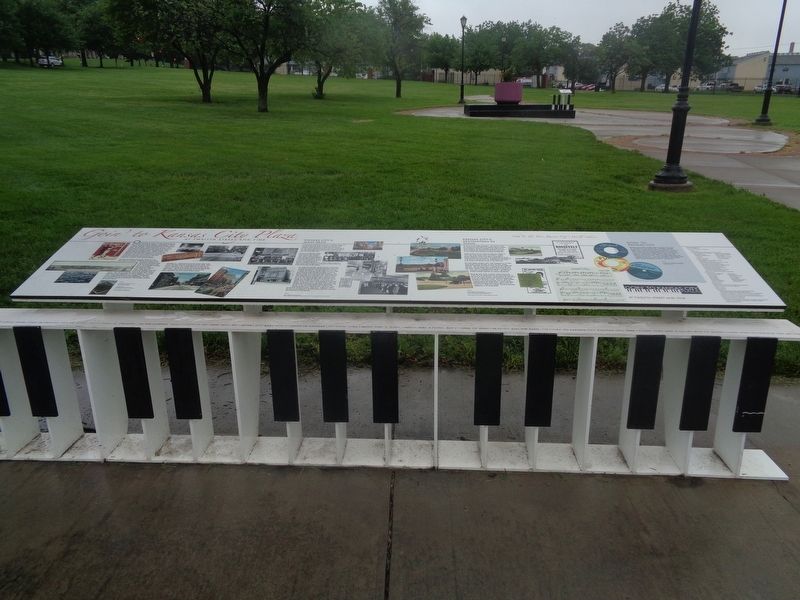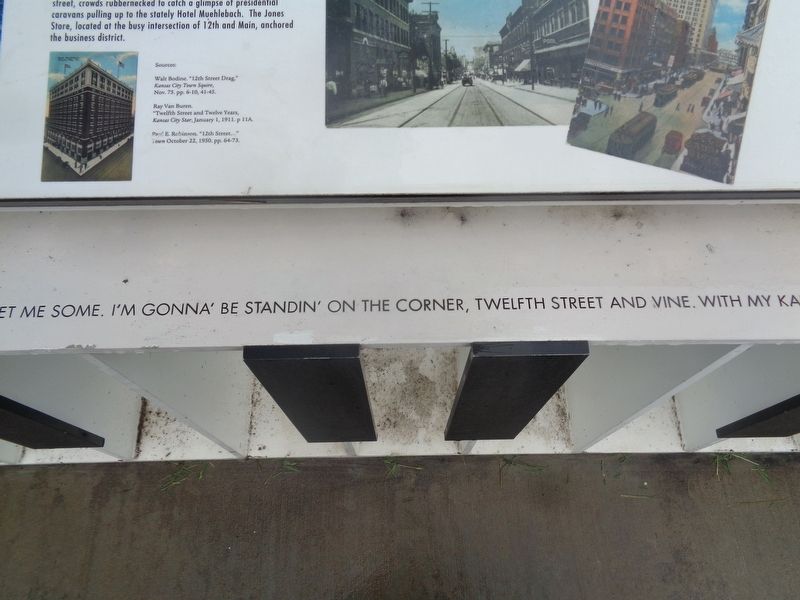Parkview in Kansas City in Jackson County, Missouri — The American Midwest (Upper Plains)
Goin' to Kansas City Plaza
at Twelfth Street and Vine
— 12th Street & Vine: Kansas City's World Address —
Inscription.
Originally known as Ottawa, 12th Street spanned from the West Bottoms, nestled in the confluence of the Kansas and Missouri rivers, to the eastern suburbs, dotted by small bungalows. At first a colorless retail strip, 12th Street blossomed into an entertainment center. Ray Van Buren, writing in the Kansas City Star in 1911, marveled at the transformation of 12th Street during the previous 12 years from a "dead line of retail and nothing more" into a "shimmering street of light and life." Ragtime composer Euday Bowman captured the bustling spirit of 12th Street with his composition "12th Street Rag," published by the Jenkins Music Company in 1916. Street cars rumbled every few minutes up and down 12th Street, one of the city's main lines. Travelers on 12th Street experience a slice of Kansas City commerce, culture and entertainment.
The 12th Street bridge connected the stockyards in the West Bottoms to downtown. Established in the early 1870s, the teeming stockyards that spread across the Bottoms grew to be the second largest in the world. Fine residences of Quality Hill crowned the bluff overlooking the stockyards. Banks, retail stores and professional buildings lined 12th Street in the downtown business district. After the first World War, future President Harry Truman operated a men's clothing shop at 12th and Baltimore. Across the street, crowds rubbernecked to catch a glimpse of presidential caravans pulling up to the stately Hotel Muehlebach. The Jones Store, located at the busy intersection of 12th and Main, anchored the business district.
Stretching east, 12th Street traversed the northern edge of the African American community centered around Vine Street. Racial barriers came down in the so-called black and tan clubs east of Troost on 12th Street, where African Americans and white patrons mixed freely. 12th Street continued east, passing through the Blue Valley industrial district before meandering to an end in the country beyond the suburbs of eastern Jackson County.
Kansas City's Main Drag
A business and entertainment center for the Midwest, Kansas City became known as the "Paris of the Plains" during the 1930s. Newspaper columnist Westbrook Pegler observed that, like Parisians, Kansas Citians were proud of their own indifference to the vice and corruption that flourished under the rule of political boss Tom Pendergast. Much of Kansas City's bright night life centered around 12th Street.
Commerce and pleasure strolled hand-in-hand down 12th Street, which sported a host of night clubs, saloons, amusement palaces, taxi dance halls and grand theaters. Patrons flocked to gaze at the stars on the silver screens at the Gayety, Empress, Standard
and Esquire theaters located on 12th Street west of Main, while a string of clubs, saloons and taxi dance joint liberally sprinkled along 12th Street offered more earthly delights.
The Vanity Fair and other upscale clubs located downtown featured full-sized bands and fast-paced floor shows with comedians and dancers. The Reno Club and other clubs crowding 12th Street east of Oak ranged from smart night spots featuring small ensembles to saloons serving up buckets of beer to the tune of stomp-down pianists. The Basie band held court at the Reno Club, tucked behind the police headquarters at 12th and Cherry. Musicians lined up in the alley behind the Reno Club to challenge Lester Young, Hot Lips Page and other stars of the band, during freewheeling all-night jam sessions. A few blocks east, Charlie Parker cut his musical teeth playing the Green Leaf Gardens and the Bar-Lu-Duc. The Sunset Club at 12th and Woodland featured boogie woogie pianist Pete Johnson and Big Joe Turner, who served thirsty patrons drinks while shouting the blues from behind the bar. Across the street, the Lonestar featured traveling stage shows. During the 1950s, the music scene continued at the Orchid Room and other clubs near the intersection of 12th and Vine.
Kansas City's Destination in Song
During the days of public segregation, 12th and Vine served as a business and social hub for the northern edge of a vibrant African American community bounded on the south by 27th Street, Holmes to the west and Benton Boulevard on the east. The area around 12th and Vine featured all the goods and services denied African Americans at businesses downtown.
Families living in the area found everything they needed on 12th Street: corner grocery stores, dry cleaners, clothing stores, pharmacies, variety stores and ice cream parlors. Dentists, physicians, lawyers and other professionals served the community from store front offices. Sanctified churches ministered to the district's spiritual needs. The Castle Theater and Crown Drugs anchored the business district at 12th and Paseo.
The Castle Theater opened in June, 1936, featuring first-run films. Heavy-weight boxing champion Joe Louis and other visiting celebrities stopped by the Castle to catch a movie and mingle with their fans. The 12th Street Revue, a popular variety stage show emceed by comedian Rabbit Sims made its debut at the Castle in July, 1939. The revue spotlighted local dancers, comedians and entertainers accompanied by jazz bands. 12th and Vine earned a national reputation as a musical destination.
During the early 1950s, social life swirled between the Jockey Club, the Boulevard Room and the Orchid Room on the corner of 12th and Vine. Located behind the Vine Street Tavern, the elegant Orchid Room featured national acts traveling on the Chitlin' Circuit. Red Foxx, Billie Holiday, the Ravens, Earl Grant and other stars on the circuit regularly played the Orchid Room. Pianist Little Willie Littlefield frequently performed an early version of "Kansas Cit" called "K.C. Loving," during an extended engagement at the Orchid Room.
Goin' to Kansas City
Written by Jerry Leiber and Mike Stoller, the song "Kansas City" put 12th and Vine on the musical map. Little Willie Littlefield recorded "K.C. Loving" the first version of "Kansas City" for the Federal Label in 1952 from the lyrics displayed below. Leiber and Stoller refined the lyrics and changed the name to "Kansas City" for the 1959 recording by Wilbert Harrison on the Fury label. An instant hit, "Kansas City" skyrocketed to number one on the Billboard chart with the lyrics "some crazy little women there and I'm gonna get me one." Since then, the Beatles, Little Richard and hundreds of other artists have recorded "Kansas City" and the catchy melody still beckons visitors to 12th and Vine.
Topics. This historical marker is listed in these topic lists: African Americans • Arts, Letters, Music • Entertainment • Industry & Commerce. A significant historical year for this entry is 1911.
Location. 39° 5.963′ N, 94° 33.771′ W. Marker is in Kansas City, Missouri, in Jackson County. It is in Parkview. Marker is on East 12th Street east of The Paseo. Touch for map. Marker is at or near this postal address: 1330 E 12th St, Kansas City MO 64106, United States of America. Touch for directions.
Other nearby markers. At least 8 other markers are within walking distance of this marker. The Rebirth of Twelfth and Vine (within shouting distance of this marker); Negro Leagues Baseball Museum (approx. half a mile away); American Jazz Museum (approx. half a mile away); Roy Wilkins (approx. 0.6 miles away); Kansas City Call (approx. 0.6 miles away); Ms. Myra Taylor (approx. 0.6 miles away); Mutual Musicians Association Building (approx. 0.6 miles away); John "Buck" O'Neil Center (approx. 0.6 miles away). Touch for a list and map of all markers in Kansas City.
Also see . . . Wilbert Harrison - "Kansas City" music/lyric video (YouTube). From Wilbert Harrison's Vevo channel. Of the many 300 versions of "Kansas City", this is the most popular version. Harrison's went to #1 on both the Billboard Hot 100 and R&B charts in 1959. In 2001, the song entered the Grammy Hall of Fame. It would also be adopted as the city's official song in 2005 while celebrating the history of Vine Street. (Submitted on June 20, 2022, by Jason Voigt of Glen Carbon, Illinois.)
Credits. This page was last revised on February 10, 2023. It was originally submitted on June 17, 2022, by Jason Voigt of Glen Carbon, Illinois. This page has been viewed 291 times since then and 58 times this year. Photos: 1, 2. submitted on June 20, 2022, by Jason Voigt of Glen Carbon, Illinois.

